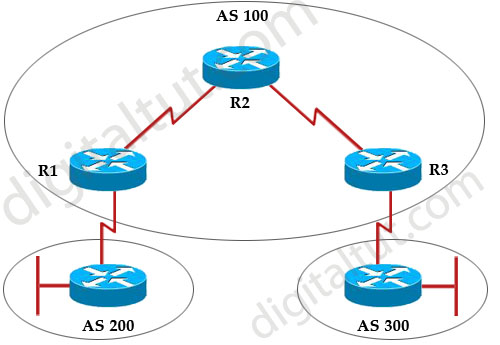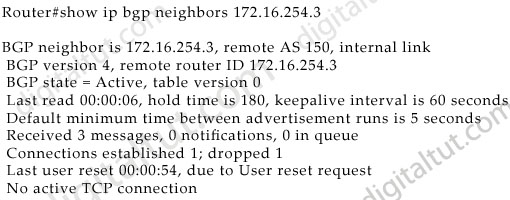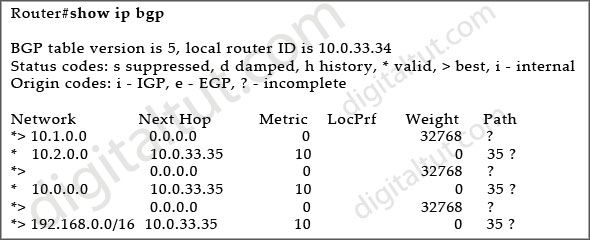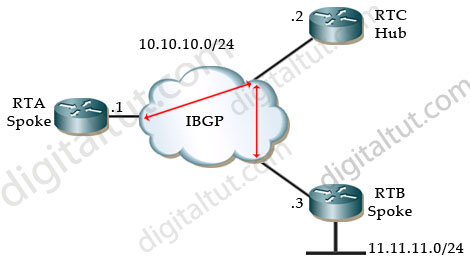BGP Questions 4
Here you will find answers to BGP Questions – Part 4
Question 1
Which two conditions can cause BGP neighbor establishment to fail? (Choose two)
A. There is an access list blocking all TCP traffic between the two BGP neighbors.
B. The IBGP neighbor is not directly connected.
C. BGP synchronization is enabled in a transit autonomous system with fully-meshed IBGP neighbors.
D. The BGP update interval is different between the two BGP neighbors.
E. The BGP neighbor is referencing an incorrect autonomous system number in its neighbor statement.
Answer: A E
Explanation
An underlying connection between two BGP speakers must be established before any routing information is exchanged. This connection takes place on TCP port 179 so if an access list blocks all TCP traffic between the two BGP neighbors, BGP neighbor relationship can not be established -> A is correct.
The IBGP neighbors don’t need to be directly connected -> B is not correct.
BGP synchronization only prevents routes sent to other EBGP neighbors before that route exists in the routing table. It doesn’t prevent BGP neighbor relationship -> C is not correct.
After the first initial exchange (which exchanges routes and synchronize their tables), a BGP speaker will only send further updates upon a change in the network topology -> BGP does not have a fixed update interval -> D is not correct.
BGP neighbor relationship is established when both ends (routers) are manually configured with the “neighborneighbor-IP remote-as neighbor-AS” command on both sides of the connection. If the neighbor-AS is wrong, the neighbor relationship can not be established -> E is correct.
Question 2
Which statement is true about EBGP?
A. An internal routing protocol can be used to reach an EBGP neighbor.
B. The next hop does not change when BGP updates are exchanged between EBGP neighbors.
C. A static route can be used to form an adjacency between neighbors.
D. EBGP requires a full mesh.
Answer: C
Explanation
When two EBGP neighbors want to establish neighbor relationship without using the directly connected interfaces (for example, use loopback interface), they must tell each other how to reach their interfaces. A static route is the most simple way to do this, especially when they are in different ASs.
Question 3
Why should iBGP sessions be fully meshed within a Transit AS?
A. BGP requires redundant TCP sessions between iBGP peers.
B. A full mesh allows for optimal routing within the Transit AS.
C. Routes learned via iBGP are never propagated to other eBGP peers.
D. Routes learned via iBGP are never propagated to other iBGP peers.
E. Routes learned via eBGP are never propagated to other iBGP peers.
Answer: D
Explanation
BGP split-horizon rule states that a route learned from one IBGP neighbor will not be advertised to another IBGP neighbor so IBGP sessions should be fully meshed. For example in the topology below, routes learned from R1 about AS 200 will be advertised to R2. For R2, the route learned from R1 is a route learned from one IBGP neighbor so R2 will not advertise this route to R3 and AS 100 can never be a transit AS -> IBGP sessions should be fully meshed within a transit AS -> D is correct.

Question 4
Which BGP feature should be used to avoid high memory utilization on a router?
A. soft-reconfiguration
B. route refresh
C. BGP communities
D. full-mesh BGP peering
Answer: B
Explanation
BGP routers have enormous routing tables so it uses much memory to proceed these routes. When a BGP policy is changed, the BGP session needs to be reset for the policy to take effect. But the resetting results in route churn and route flapping. There are two ways to clear a BGP session without resetting the TCP session between them (this is often called “soft reset”):
Soft-reconfiguration: stores all received (inbound) routing policy updates without modification in a table so that when a new filter is applied, the router will use this table to calculate the changes without resetting the TCP session between the two BGP peers . This is a memory-intensive (high memory utilization) method and is not recommended.
Route-refresh: allows a BGP router to request a remote peer resend its BGP Adj-RIB-Out. This allows the BGP router to reapply the inbound policy. The route-refresh capability requires no extra memory on the local router
Question 5
For the accompanying router output, which of the following statements describes the state that neighbor 172.16.254.3 is in?

A. The router will not accept connections from the peer.
B. The router has sent out an active TCP connection request to the peer.
C. The router is listening on its server port for connection requests from the peer.
D. BGP can exchange routing information in this state.
Answer: C
Explanation
The BGP state in the output is “Active”, which means BGP speaker is attempting to initiate a TCP session with the BGP speaker it wants to peer with. If this can be done, the BGP state goes to OpenSent state.
Question 6
A router has two paths to reach another network in a different autonomous system. Neither route was generated by the local router and both routes have the same default weight and local preference values. Which statement is true about how BGP would select the best path?
A. If the command bgp always-compare-med has been given, then the router will prefer the route with the highest MED.
B. The router will prefer the route with the lower MED.
C. The router will prefer the shortest autonomous system path.
D. To influence one route to be preferred, its default local preference value will be changed via the use of the command bgp default local-preference 50.
Answer: C
Explanation
In the Route selection decision process, if the weight, local preference & route originated are the same then the shortest AS path will be chosen.
The full Route selection decision process is listed below:
1. Prefer highest weight (local to router)
2. Prefer highest local preference (global within AS)
3. Prefer route originated by the local router (next hop = 0.0.0.0)
4. Prefer shortest AS path
5. Prefer lowest origin code (IGP < EGP )
6. Prefer lowest MED (exchanged between autonomous systems)
7. Prefer EBGP path over IBGP path
8. Prefer the path through the closest IGP neighbor (IGP cost)
9. Prefer oldest route for EBGP paths
10. Prefer the path with the lowest neighbor BGP router ID
11. Prefer the path with the lowest neighbor IP address
Question 7
Refer to the exhibit. Which two statements are correct? (Choose two)

A. All six routes will be installed in the routing table.
B. Two routes will be installed in the routing table.
C. Four routes will be installed in the routing table.
D. All the routes were redistributed into BGP from an IGP.
E. All the routes were originated by BGP with the network command.
Answer: C D
Explanation
Only the valid & best routes (represented by *>) will be installed into the routing table -> C is correct.
The “?” under the “Path” column means that origin of the path is not clear. Usually, this is a router that is redistributed into BGP from an IGP. -> D is correct. (Reference: http://www.cisco.com/c/en/us/td/docs/ios/iproute_bgp/command/reference/irg_book/irg_bgp5.html)
Question 8
Which two statements are true about IBGP neighbor relationships? (Choose two)
A. An EGP or static routing is required between IBGP neighbors.
B. A full-mesh IBGP requires that neighbor relationships be established between all BGP enabled routers in the autonomous system.
C. IBGP neighbors must be in different autonomous systems.
D. The BGP split-horizon rule specifies that routes learned via EBGP are never propagated to other IBGP peers.
E. The BGP split horizon rule specifies that routes learned via IBGP are never propagated to other IBGP peers.
Answer: B E
Question 9
Refer to the exhibit. Which two statements are true about the partial configuration that is provided. (Choose two)
| router bgp 100 neighbor internal peer-group neighbor internal remote-as 100 neighbor internal update-source loopback 0 neighbor internal route-map set-med out neighbor internal filter-list 1 out neighbor internal filter-list 2 in neighbor 171.69.232.53 peer-group internal neighbor 171.69.232.54 peer-group internal neighbor 171.69.232.55 peer-group internal neighbor 171.69.232.55 filter-list 3 in |
A. All the configured neighbors are in autonomous system 100.
B. The peer group shortens the IBGP configuration.
C. The peer group shortens the EBGP configuration.
D. Only the outgoing filters are applied to BGP updates.
E. Three AS-path filters are applied to each BGP neighbor.
Answer: A B
Explanation
This is an IBGP peer group because the AS numbers in “router bgp {AS number}” and “neighbor internal remote-as {AS number} are the same -> A is correct.
A BGP peer group reduces the load on system resources by allowing the routing table to be checked only once, and updates to be replicated to all peer group members instead of being done individually for each peer in the peer group. In addition, a BGP peer group also simplifies the BGP configuration -> B is correct.
This is the process of creating a peer-group (used the output above):
| neighbor internal peer-group | Create a peer-group (named internal) |
| neighbor internal remote-as 100 neighbor internal update-source loopback 0 neighbor internal route-map set-med out neighbor internal filter-list 1 out neighbor internal filter-list 2 in |
Configure needed commands for the peer-group |
| neighbor 171.69.232.53 peer-group internal neighbor 171.69.232.54 peer-group internal neighbor 171.69.232.55 peer-group internal |
Assign BGP neighbor into a peer group |
Just one thing to notice is the last command “neighbor 171.69.232.55 filter-list 3 in” indicates the filter-list 3 will be applied for neighbor 171.69.232.55 while other neighbors will be applied filter-list 2 as the inbound filter-list (all neighbors use outbound filter-list 1).
Question 10
Observe the diagram. RTC is the hub router and RTA and RTB are the spokes. There are no virtual circuits between the spoke locations. What is needed to successfully route traffic to the 11.11.11.0/24 network from RTA?

A. The neighbor 10.10.10.1 next-hop-self command on RTA.
B. The neighbor 10.10.10.1 next-hop-self command on RTB.
C. The neighbor 10.10.10.1 next-hop-self command on RTC.
D. Nothing is required. This is the default behavior on this topology.
Answer: C
Explanation
The next-hop-self command must be used on RTC to specify RTC’s IP address as the source address in the packets sent to RTB (and RTB knows how to reach RTC but it does not know how to reach RTA).
Question 11
A router is running BGP and receives more than one route for a particular prefix. Assume all the routes for this prefix have the same attributes. Which three path features would be reasons be for the router to ignore some of the routes and not consider them as candidates for the best path? (Choose three)
A. paths that are marked as synchronized in the show ip bgp output
B. paths that are marked as not synchronized in the show ip bgp output
C. paths for which the NEXT_HOP is accessible
D. paths for which the NEXT_HOP is inaccessible
E. paths from an external BGP (eBGP) neighbor if the local autonomous system (AS) appears in the AS_PATH
F. paths from an internal BGP (iBGP) neighbor if the local autonomous system (AS) appears in the AS_PATH
Answer: B D E
Explanation
Only synchronized routes (answer B) with no AS loops (answer E) and a valid next hop (answer D) will be considered as candidates for the best path route selection decision process.



Hi everyone,
SEO surgiu com a nova geração de motores de pesquisa. http://south-Wind.chicappa.jp/html/yybbs/yybbs.cgi?list=thread
hi
Where are you?